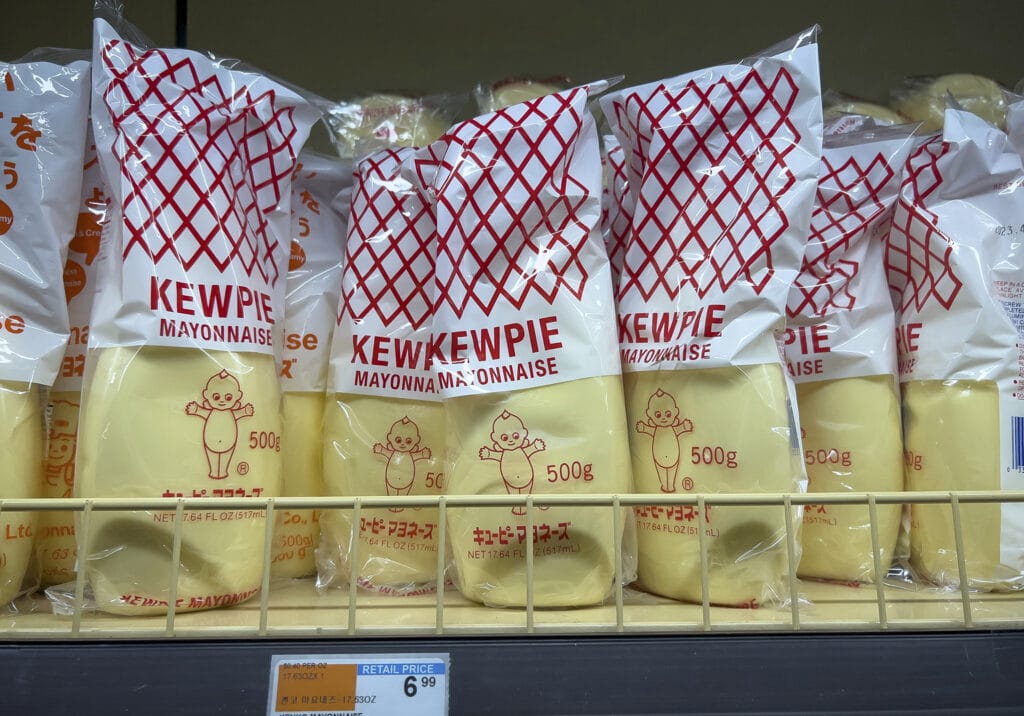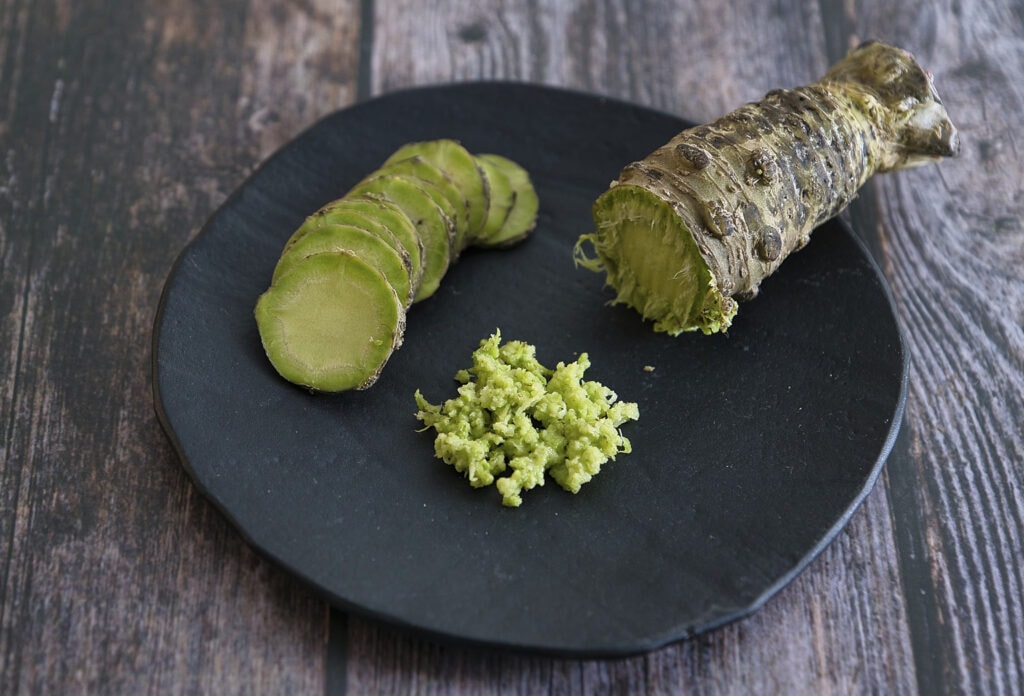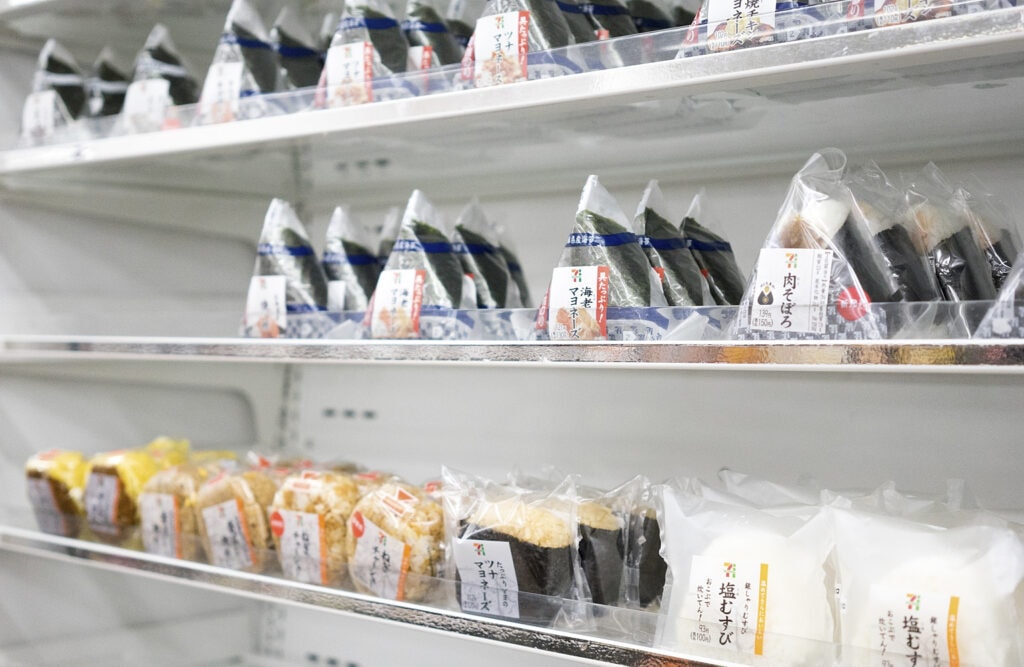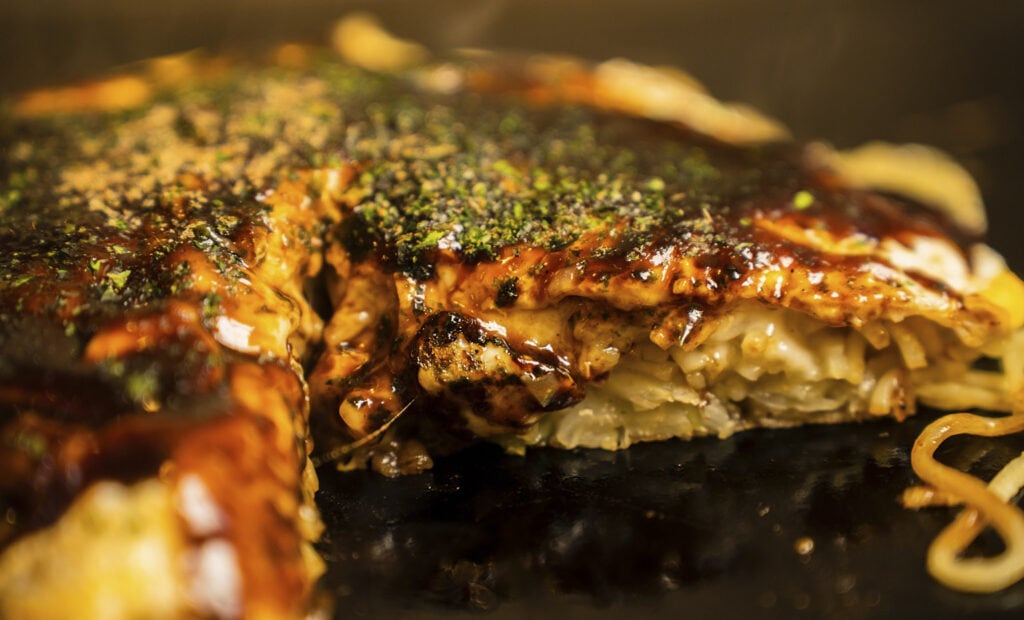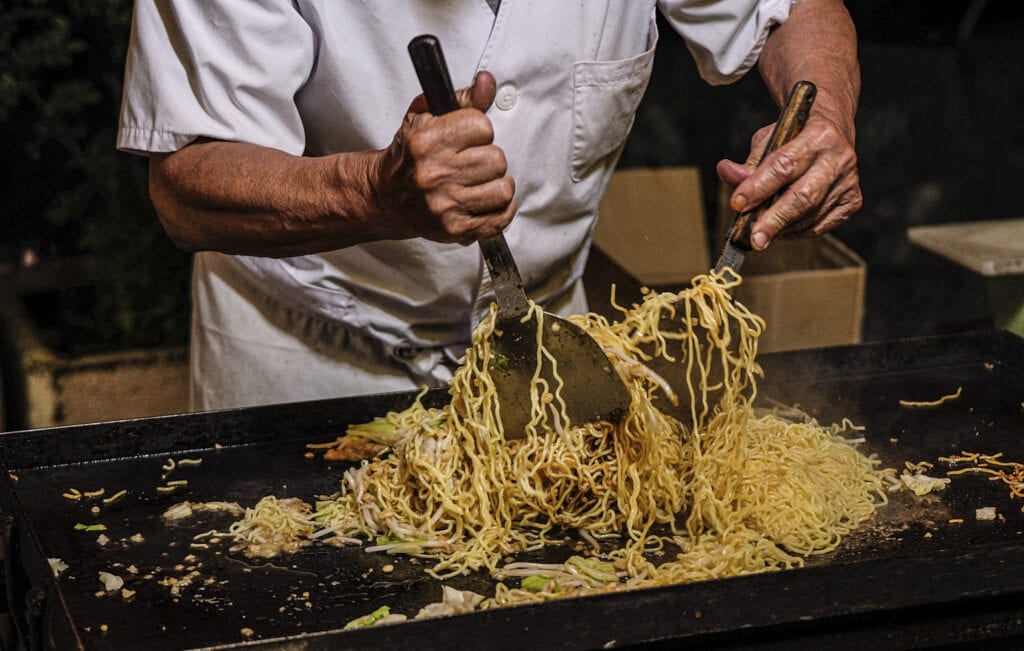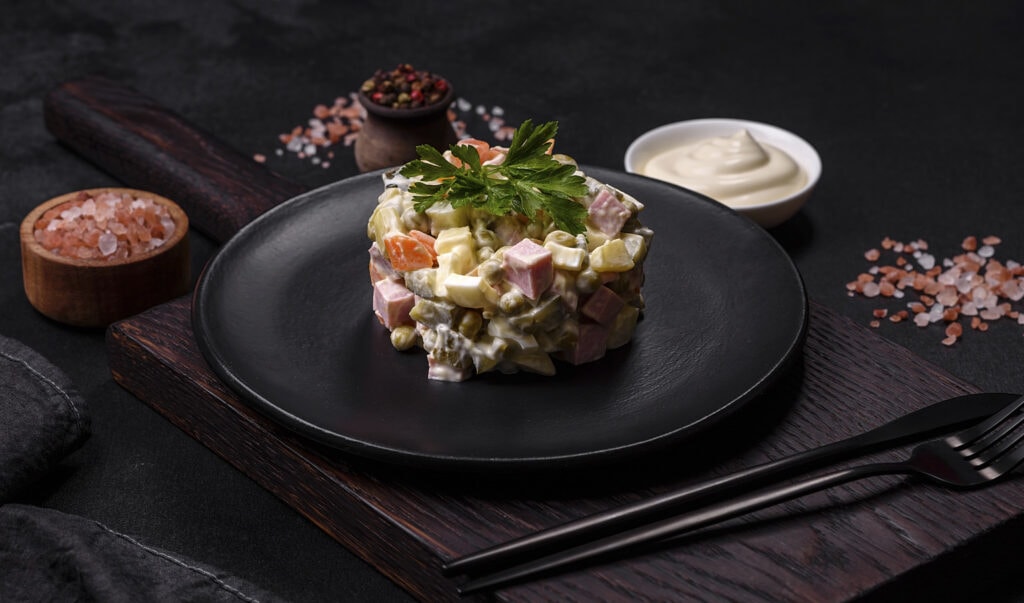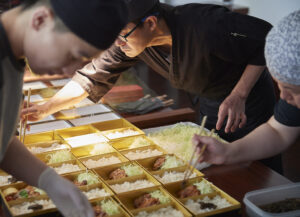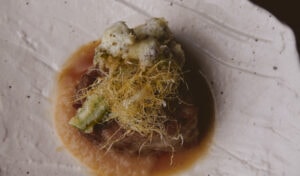Japan - who in Germany doesn't commonly think of Sushi, healthy food, long life, finest ingredients and maybe still Soy sauce and miso paste? Some people will be surprised to learn that Japan is a country that nowadays is almost unthinkable without mayonnaise of all things!
Fact: Without mayonnaise, okonomiyaki (お好み焼き), yakisoba (焼きそば), takoyaki (たこ焼き), katsu-sando (カツサンド), onigiri (おにぎり) and potato salad (ポテサラ), all typical Japanese dishes, are completely unthinkable.
And it can't be just any mayonnaise, it has to be Japanese mayonnaise. Wait a minute - is it different? And isn't potato salad a quintessentially German dish?
Yes, yes and no. Yes, Japanese mayonnaise is different and has nothing in common with the reduced-fat light products for figure-regenerating salads from German supermarkets except the name. And yes, potato salad is also a German dish. But no, that doesn't mean that people in Japan don't have their own idea of potato salad - just like mayonnaise. And now we'll get into the details, but in order.
When did the Japanese love of mayonnaise get its start?
In 1912, a Japanese man named Nakashima Toichiro (Kanji we are still researching...), then 19 years old, is said to have encountered mayonnaise in the USA and Europe.
The young man was on a training trip, sent by the Japanese Ministry of Agriculture. This can all still be verified so far. Nakashima is said to have been enthusiastic about mayonnaise. We were unable to verify this (see https://asienspiegel.ch/2019/03/das-mayonnaise-land-japan).
Back in Japan, Nakashima founded the food company Shokuhin Kogyo in 1919. But it was not until six years later, in 1925, that he succeeded in launching a Japanese mayonnaise product. Kewpie mayonnaise was born!
Mayonnaise popular in Japan since its launch
In the very first year, 600 kilograms of the product, which had previously been completely unknown in Japan, were sold. In the second year, Shokuhin Kogyo was able to sell an impressive seven tons of mayonnaise. Sales figures rose steadily, and Kewpie Mayonnaise is still the most popular mayonnaise in Japan today.
Difference between Japanese and European mayonnaise
Unlike European mayonnaise, in Japan only the yolk and not the whole egg is used in the mayonnaise. Together with vegetable oil, vinegar and spices, that's all the product needs. The packaging is kept as simple as possible, on the Western market it would not even work.
Kewpie dolls: Designed by an American, made in Germany, loved in Japan
Early advertising for mayonnaise jumped on an international rolling advertising bandwagon.
The company took advantage of Rose O'Neill's designs, which had been popular internationally since the 1940s. She had designed a little naked boy, chubby-cheeked, who had already been adopted early on by Colgate, Kellog's and other companies. She called the figure Kewpie, and the illustrations were soon used to design dolls.
The Kewpie Mayonnaise logo and mascot was not a purely Japanese thing, but - like mayonnaise itself - a fad adapted from the West (see https://www.kewpie-jp.com/about/doll-100th.html).
According to the slogan, little Cupid, a fat baby, is supposed to guarantee "love on the dinner table. And that's where the name of the mayonnaise comes from: Kewpie is the short derivation of the English word "cupid", meaning a cupid. The cute little baroque angel is none other than the god of love from Roman mythology. The doll for the logo comes from Ohrdruf in Thuringia (cf.
https://de.wikipedia.org/wiki/Kewpie and https://en.wikipedia.org/wiki/Kewpie).
By the way, it didn't stop at just one mayonnaise. Kewpie mayonnaise now comes in many different varieties and is also available in Europe. Shokuhin Kogyo has been called Kewpie Corporation since 1957, in order to build extensively on the success of its own product.
100 Years of Mayo Nation Japan: 3 Fun Facts!
When a product is as popular as mayonnaise in Japan, there are one or two curious facts about it - especially in Japan. We have collected a few fun facts about mayonnaise and Kewpie.
Pop-up café for the company's 100th anniversary
Nakashima could not have imagined what he was setting in motion in 1925. The land of soy sauce became the land of mayonnaise, so to speak, overnight. To celebrate the founding of the company now known as Kewpie Corporation, the manufacturer opened a temporary Kewpie Café in an illustrious department store and office complex in Roppongi in 2019. The "kewpie 100 years, start! CAFÈ" served salads, sandwiches and other small dishes, all of which contained mayonnaise. Those who preferred dessert could try a mayonnaise pudding. The café closed again in Tokyo on March 31, 2019, but as a pop-up store, it also visited other Japanese cities (cf. https://www.kewpie.co.jp/100th/cafe/).
Mayoterrace: Kewpie Mayonnaise Museum in Tōkyō
The Kewpie Corporation has now dedicated an entire museum to mayonnaise in Tōkyō, where guests can learn about the history of mayonnaise and how it is made, including all the processes and machines, and can also enjoy a tasting similar to a wine tasting (see https://www.kewpie.co.jp/entertainment/mayoterrace/). Not surprisingly for Japan connoisseurs, the Mayoterrace restaurant is designed as a building in the shape of a giant, inverted mayo bottle from the Kewpie company; the outer shell is transparent.
Green mayonnaise, red mayonnaise, yellow mayonnaise, brown mayonnaise: variety!
In the 21st century, there are not only countless special varieties of mayonnaise in Japan, but special stores that sell only mayonnaise in its different variations. Of course, the most popular is still the classic Kewpie mayonnaise. Varieties that might be rather rare to find in Germany are wasabi mayo, lemon mayo, sesame mayo and Sriracha mayo.
Pudding with mayonnaise and mayonnaise ice cream
Mayonnaise wird zwar im Westen eher deftigen Gerichten als Sauce beigegeben, in Japan hat es die Mayonnaise aber auch in die Desserts geschafft. Rezepte für Mayonnaise-Pudding (マヨネーズプリン) gibt es bei Cookpad, der in Japan beliebtesten Anlaufstelle für Rezepte im Internet. Mayonnaise-Kakigori (マヨネーズかき氷) soll bei Matsuri und in etwas spezielleren Cafés (vgl. http://www.3-kyo.co.jp/community/2020/03/18/%E3%83%9E%E3%83%A8%E3%83%8D%E3%83%BC%E3%82%BA%E3%81%8B%E3%81%8D%E6%B0%B7%E3%81%8B%E3%81%A3%EF%BC%81/) erhältlich sein. Tipp für Hausfrauen: Soll der Pudding besonders sanft und cremig werden (japanischer Pudding ist so eine Art Creme Brulee), dann hilft es, etwas Mayonnaise beizumischen (vgl. https://www.kewpie.co.jp/recipes/recipe/QP10001410/).
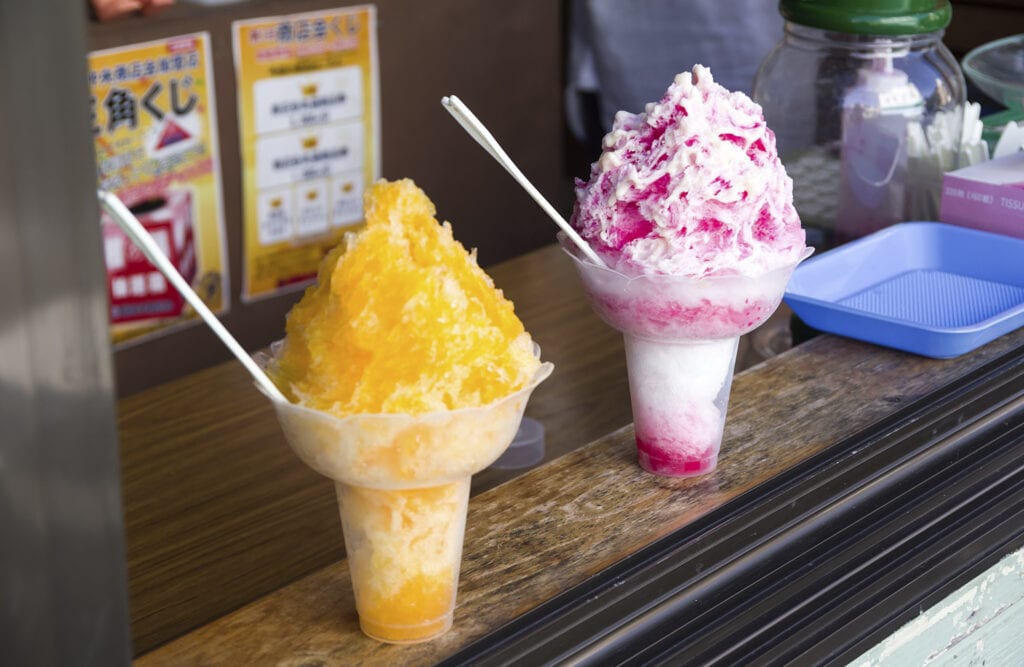
What dishes call for mayonnaise in Japan?
Despite the odd dessert made with mayonnaise, the fine seasoning sauce is primarily served with hearty dishes in Japan. Mayonnaise has a firm place in home cooking and plays an important role in street food and picnic dishes. It is primarily the rather greasy, deep-fried dishes that are enhanced with mayonnaise. This is because Japanese mayonnaise does not have such a greasy texture as Western mayonnaises, it is finer and creamier.
Quite often housewives put a little mayonnaise on cooked asparagus, on cauliflower and broccoli. The vegetables are served as a small side dish, often cold. So it is not exclusively heavy dishes that benefit from the taste of mayonnaise.
Onigiri: mayonnaise as an important ingredient
Onigiri (おにぎり) are considered a typical and original Japanese take-out food.
The small rice balls are available in konbini and supermarkets, but are also often made for picnics and bentos at home. They are filled with all sorts of things: Tamagoyaki (卵焼き) or peas, corn or grilled salmon can hide in the rice.
But it is especially common to find cooked shrimp (マヨネーズ海老), cooked tuna (マヨネーズツナ), deep-fried chicken ( 鶏唐揚げマヨネーズ) or egg (半熱煮玉子・マヨネーズ入り), which sits coated with a layer of mayonnaise or mixed in the center of the onigiri. According to the ranking, tuna mayo is currently the most popular option, at least among onigiri sold in Konbini (see https://ranking.net/rankings/best-rice-balls).
Little history of onigiri
Today, onigiri are typically Japanese. The first written reference to the small balls is found in the diary of Murasaki Shikibu, a lady-in-waiting and writer of the Heian period (794-1185).
Called tonjiki at the time, they were mayonnaise-free travel provisions and small offerings for servants and bodyguards. In the Kamakura period (1185-1333), the handy balls served as rations for troops of soldiers in battle. Umeboshi were used as a filling very early on, and various vegetables were also used. By the way, originally red and black rice was used, the white uruchi-mai appeared only in the Sengoku period (1467-1603) and prevailed in the country after 1590.
Okonomiyaki - simply not complete without mayonnaise
Okonomiyaki (お好み焼き) is a type of pancake that is homemade at the table on a hot plate. Cabbage, fish, various vegetables and meat, mochi or cheese are placed on the plate, cooked briefly and then covered with the pancake batter and cooked until done. Alternatively, the chopped ingredients can be mixed with the pancake batter and then all cooked together. The dish is considered a specialty of the Kansai region and is especially popular in Ōsaka. The Tōkyōter equivalent would be monjayaki (もんじゃ焼き).
Okonomiyaki is first baked on both sides, split with a spatula on the hot plate and turned over. Then the individual pieces are covered with nori (のり) and Katsuōbushi (鰹節), with mayonnaise and ginger and enjoyed. Theoretically, you could leave out the mayonnaise - but then the loose ingredients wouldn't hold onto the pancake at all, so the construct wouldn't be as easily edible. Okonomiyaki is typically eaten in restaurants, at home you prepare it in a pan.
Small history of Okonomiyaki
The origins of okonomiyaki can be found in Kyōto and are thought to date back to between 1681 and 1684. Mayonnaise did not exist in Japan at that time, of course, and the pancake batter was prepared on the basis of rice flour (now wheat flour) and enriched with seasonal ingredients. It wasn't until a good 50 years later that the recipe spread to other parts of Japan, wheat flour was used instead of rice flour, and at some point Worcestershire sauce was added. People experimented with different toppings. After the Great Earthquake of 1923, okonomiyaki spread from Tōkyō to Ōsaka, Hiroshima, and Kōbe. From then on, the regional differences so prominent today developed.
Yakisoba: No matsuri without the fried noodles!
Yakisoba (焼そば) literally translates as "fried buckwheat".
But in fact it is some kind of noodles (usually made from wheat flour), the pre-cooked noodles are fried with vegetables, meat or fish and a sauce. The sauce is made by each vendor of this street food itself, the basis for which is soy sauce and oyster sauce.
Yakisoba are traceable in Japan since the beginning of the 20th century and is indispensable from festivals (matsuri, 祭り) in temples, shrines, schools, districts and so on. The fried noodles are decorated with mayonnaise and sprinkled with ao-nori (青のり) and other seasoning ingredients. As with okonomiyaki, the same applies here: Without mayonnaise, the seasoning would not hold well, and the dish would not be as easy to eat standing up. Yakisoba have been established in Japan since the 1930s.
Katsu-Sando
If you are hungry on the road in Japan, you either get a bento or a snack in a konbini. The alternative to the onigiri already discussed are sandwiches. However, they don't have much in common with the butter sandwiches or sandwiches from the bakery that are familiar in Germany. Sandwiches, known as sando (サンド) for short, consist of a soft slice of white bread modeled on American sandwich toast, which can be spread with mayonnaise (instead of butter) and topped with lettuce, ham, cheese, fish, egg or other ingredients. Mayonnaise is essential because it performs the same function as butter on bread in Germany: it fixes the topping.
But that's not all. Sando can also be "topped" with potato salad (more on that later) or egg salad. Tamago-Sando (卵サンド) carry a filling of half-cooked egg, mixed with mayonnaise and seasoned. Katsu-sando (カツサンド) are topped with a Japanese version of cutlet, usually cut into strips and served on a bowl of rice (katsudon, カツ丼). As with katsudon, mayonnaise is also used as a creamy mild sauce (see https://www.kurashiru.com/recipes/daac180b-4078-4b89-9483-ba1535475039).
The Japanese potato salad
There are, of course, very different recipes for potato salad all over the world.
In Germany alone, there are already two major movements: While in the southwest potato salad is usually marinated with a clear, vinegar-based sauce, in other areas a mayonnaise-based sauce is used, often mixed with yogurt. The first version can be found in variations (a decoction of meat broth, vinegar, oil and spices) also in Austria to Croatia, sometimes the salad is served even still warm. The version with mayonnaise is known beyond Germany in Silesia and Bohemia, in the Rhineland gherkins or apples are added, in Brandenburg it may also be radishes.
The Charivari - the salad is actually called that and probably has nothing to do with the warlock from Jonathan Stroud's "Skulduggery Pleasant" - is the French version of potato salad and mixes the potato with apples, pears, mushrooms and beet as well as pickled cucumbers, the dressing is made from mayonnaise. In Spain and Latin America people know the "Ensaladilla rosa", translated Russian salad. And this is enriched with carrots, peas and tuna as well as asparagus in addition to potatoes; regionally, peppers, sour beans and even olives are added. So it's clear: potato salad is not a typically German affair.
Origin of potato salad: possibly a Russian salad unknown today
With today's worldwide distribution, it is difficult to trace where the potato salad originally came from. Especially on the Internet circulate quite peculiar stories and legends.
For example, the "Association of Japanese Potato Salads" (nihon potetosarada kyōkai, 日本ポテトサラダ協会) suspects that the origin of the potato salad in the variant known today in Japan is in Russia. Namely, one sees the Olivier salad as a predecessor.
Frenchman Richouin Olivier worked as a cook in the Moscow restaurant "Hermitage" and served a salad with potatoes in this establishment, opened in 1864. Olivier eventually died, leaving no recipe, and no one knew how his delicious salad was prepared. Russian restaurants, however, serve Olivier salad to this day. And it is actually much more similar to Japanese potato salad in ingredients, consistency and taste than any of the regionally very different potato salads of today (see https://potasala.jp/potasala-history/).
Potato salad in Japan since Meiji period
Potato salad is now an integral part of Japanese cuisine and a popular side dish. Exactly how potato salad came to Japan is not clear. Presumably, what is now known as potato salad in Japan was developed by a Japanese chef around the year 1896. According to legend, this chef wanted to recreate the Russian Olivier salad. There was no recipe at that time. Later, however, the Japanese chef's recipe was published in Japan, and by the 1950s potato salad had made it into Japanese households.
Potato salad is not the only dish that emerged from Western adaptations in Japan during the Meiji period (1868-1912). During the Meiji period, Japan slowly opened up after centuries of isolation, and numerous influences from the West entered the country. Tonkatsu (トンカツ, the "cutlet" in katsudon and katsu-sando) was born during the Meiji period, as was korroke (コロッケ, known in the West as croquette or croquette) and kare-raisu (カレーライス, British-style curry rice).
What is special about Japanese potato salad
Japanese potato salad is made from boiled, coarsely mashed potatoes mixed with mayonnaise, boiled egg, rice vinegar and mustard. Salty pickled cucumber and carrots, maybe some ham, can round out the potato salad.
It is true that in Japan potato salad is often served with tonkatsu, the side dish is found in bentos and can be found in izakaya. But actually it belongs to domestic cuisine. And there it is in Japan a little bit like in Swabia: Every housewife has her own top-secret recipe!
By the way, currently we have a fine Japanese potato salad at our restaurant sansaro, for example to our fine Tonteki. We are curious: can you taste the difference?
Appendix & Sources:
https://de.wikipedia.org/wiki/Kewpie
https://en.wikipedia.org/wiki/Kewpie
https://www.kewpie-jp.com/about/doll-100th.html
https://en.wikipedia.org/wiki/Kewpie_(mayonnaise)
https://www.kewpie.co.jp/100th/cafe/
https://www.kewpie.co.jp/recipes/recipe/QP10001410/
https://wanderweib.de/tipps-onigiri-japan-reisball/#Sorten
https://ranking.net/rankings/best-rice-balls
https://www.kurashiru.com/recipes/daac180b-4078-4b89-9483-ba1535475039
https://asienspiegel.ch/2017/06/im-okonomiyaki-paradies
https://1mal1japan.de/japanische-kueche/okonomiyaki/
https://www.japandigest.de/reisen/essen/essen/geschichte-der-onigiri/
https://1mal1japan.de/rezepte/yakisoba/
https://de.wikipedia.org/wiki/Kartoffelsalat#Zubereitung_und_Varianten
https://vickysreisschale.de/japanischer-kartoffelsalat/
https://z-upload.facebook.com/BotschaftJapan.Deutschland/posts/3134380026838069
https://ja.wikipedia.org/wiki/%E3%83%9D%E3%83%86%E3%83%88%E3%82%B5%E3%83%A9%E3%83%80
